Who does such nonsense and grows nettles on the balcony? And what for? Everyone knows that they are weeds. And every child knows that they burn terribly.
Not everyone knows how healthy this WILD HERB and HEALING PLANT is.
Stinging nettle is a superfood.
That’s what it’s called these days. Nettles are our most valuable native “superfood” with top levels of protein, iron and chlorophyll. It contains 30 times as much vitamin C and 50 times as much iron as lettuce. The healing effects of stinging nettle are described as follows:
- blood purifying
- draining
- hematopoietic
- potency-enhancing
- lowers the blood sugar level
- Promotes hair growth
- for rheumatic diseases.

When I was a child, my mother always looked for young nettle plants in spring, harvested them and drank several cups of tea from them every day. I followed in her footsteps and often took such a vitalizing cure in spring. In the meantime, nettles have become an important and valuable ingredient in my green smoothies, which I no longer want to do without. I feel much fitter, more vital and more energetic since I have been enjoying them every day. When I drink a green smoothie, I can clearly feel the energy boost. I also really appreciate the blood-purifying and draining effect of the nettle plant. Having taken a lot of medication in the past, using nettles makes me feel good: the nettle removes toxins and metabolic waste products by stimulating kidney function. More water is now excreted and with the water also a higher proportion of toxins and harmful substances.

So why not grow nettles on your balcony?
When I’m on vacation in unspoiled nature, I always take a supply with me from there. I also dried a lot this year, but fresh plants are better. In the city, it’s more difficult to get hold of good plants, although nettles often grow in parks and on grass verges. But I don’t want to eat them, how many dogs might have already peed on them? So I tried it myself in spring by sowing nettle seeds that I had harvested the previous year and had stored dry over the fall/winter in a balcony box with normal compost soil. The seed germinated, sprouted and thrived. It was fun to watch. I was able to harvest in the summer. In September, I sowed a second balcony box with ripe (yellowish colored) seeds that I had harvested on vacation.
This summer I harvested a lot of ripe nettle seeds, as I now know how much protein the seeds contain. It also contains vitamins A, B, C, E, potassium, iron, calcium, carotenoids and Chlorophyll. I also add a portion of the dried nettle seeds to my morning green smoothie from time to time. In any case, the second balcony box with nettles also sprouted excellently and grew. It’s such a pleasure to step out onto the balcony in the morning and harvest the ingredients for your green smoothie directly on the balcony — without losing any vital substances through transportation or storage. In the meantime, stinging nettles keep sprouting up all by themselves, I’m happy about it, let them grow and harvest this superfood. It’s all part of the organic balcony.
Nettles for butterflies
Wusstest Du, wie viele Schmetterlinge von der guten Brennnessel leben? Wow. Die Brennnessel ist Food plant for the caterpillars of around 49 butterfly species (Raupenfutterpflanze). Für vier einheimische Tagfalter ist sie sogar die einzige mögliche Futterpflanze: Kleiner Fuchs, Tagpfauenauge, Admiral und Landkärtchen. Nachdem im letzten Jahr ein Tagpfauenauge zu mir in den 6. Stock in Berlin City hochgeflogen ist, hoffe ich auf Wiederholung in diesem Jahr. Vielleicht legt es Eier bei mir ab. Eine Leserin empfahl, ein paar trockene Äste schön dicht in der Nähe aufzustellen. Dort verpuppen sie sich gern, damit sie vor Fraßfeinden sicher sind. Eine Kombination aus Nektarpflanzen (z. B. Dost, Salbei, Zitronenmelisse, Minzen) und Brennnesseln hilft, dass die Schmetterlinge für Nachwuchs sorgen. Söhnchen und ich würden uns sehr freuen.
Does it even make sense to grow nettles for butterflies on the balcony, a small stand of nettles, in a tub?
Dr. Michael Altmoos says in the 6th Organic Balcony Congress 2021So stinging nettles are super plants in every respect, but not all stinging nettles are the same — the butterfly species mentioned are specialized in different niches. The land moth prefers nettles as a caterpillar plant in humid places, i.e. in the shade. The small fox — nettles are best in full sun. If you have a south-facing balcony, the small fox could be there. The admiral doesn’t like large stands of nettles at all, but only at the edge, so individual nettles could well attract it to the balcony. And so the nettle butterflies are mixed in differently — they all like the nettle, but sometimes shady, sometimes sunny, sometimes standing alone. If you have the space and the opportunity, nettles in different locations, sometimes larger, sometimes smaller, are of course the plant of choice. Variety is alive and well, even with nettles.
That’s really quite exciting, because more and more people are going crazy and eating nettles and other wild plants, and it’s important to know whether we would then really be providing food for moths, for the caterpillars.
A very clear yes. As I said, stinging nettles in different locations attract different butterflies, the diversity is alive, and if you want to specifically promote the small fox, stinging nettles in full sun, and more in the airy shade, the land carrot. In my butterfly garden, I’ve managed it — but there’s also the space: nettles in the shade, full sun, few nettles, large nettle field, so you can vary and this also results in diversity for butterflies. You generally don’t go wrong with stinging nettles, but as I said, even if stinging nettle is a bit of a fad, it’s a wonderful plant, but also think about the small, forgotten, inconspicuous meagre herbs, which are even more important for butterflies.
We have them on the canopy — diversity in all respects. I’m still wondering whether such a stock in a balcony box would be something.
It’s difficult to say because it depends on the environment. In general, yes, you have the opportunity, but never the guarantee. Nature gives no guarantees, but we are on the playing field of possibilities, which is a wonderful thing.
The congress is called “Can animals be planted?”, so that would also fit.
They increase the probability, but I’ve also seen people who were angry if the animal wasn’t there after two years. Nature gives no guarantees. We offer possibilities, probabilities and promote animal life and life also consists of coincidences. We increase the probability that animals can be planted, so to speak, in the sense of probability, an offer of life chances. And that is important.”
Nettles to strengthen plants
Due to their constituents, nettles are very valuable ingredients for herbal infusions, herbal broths and teas — all preparations with which you can strengthen your plants. You can read herehow you can use nettles, among other things, to strengthen your plants so that they are not susceptible to pests. It works for me.



Here you can get the best quality organic young nettle plants for your balcony
Bioland nursery Umbach The organic balcony movement receives a discount code Organic balcony5 on every online purchase 5 % discount! (Add the Bio-Balkon5 voucher in the “Gift voucher or discount voucher” field at checkout).
Here you can get the best organic seeds of the power plant stinging nettle
Natural garden seeds from Leipzig with the following tips from Janet Glausch:
Location: semi-shady, nutritious
Lifespan: perennial
Flowering: green, July-October, from the 2nd year onwards
Height: 100–200 cm
Spacing: 30 cm (10 plants/m²)
Sowing: March-April in pots outdoors
Sowing depth: 0 cm (light germinator)
Germination period: 3–6 weeks at 10–15°C (cold germination)
Keep moist after sowing!
Want to learn more (as a city dweller)? My online course “Growing the 3 most important edible wild plants yourself”
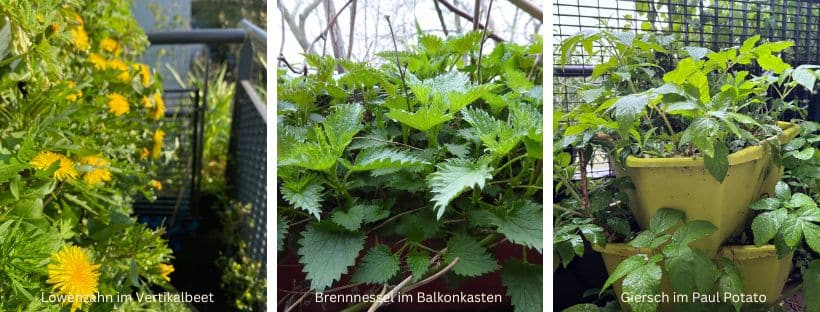
You can learn how to grow your own edible wild plants rich in vital nutrients on your balcony or windowsill in three steps in my Online course on edible wild plants:
- Module 1: Basics of sustainable balcony gardening
- Module 2: Stinging nettle: medicinal plant of the year 2022
- Module 3: Dandelion: the small, yellow sun of spring
- Module 4: Goutweed: favorite wild and medicinal plant
- BonusesPlant creatures from herbalist Christel Ströbel as well as delicious, everyday & healthy recipes (tasty, quick to make, beautifully designed for download)
Here you can get the right plants in a pack of three in the best organic Demeter quality:
Demeter Kräutergarten Urban als 3MALWILD
Book recommendations
Finally, some book recommendations from two authors I hold in high esteem. Both are great herbalists and nature lovers:
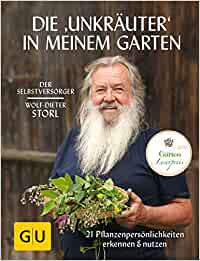

So nettles from the balcony.
They are leafy vegetables, superfoods, medicinal plants, plant strengtheners, pest control agents and caterpillar food plants for butterflies. Grow them. It works best in the balcony box.


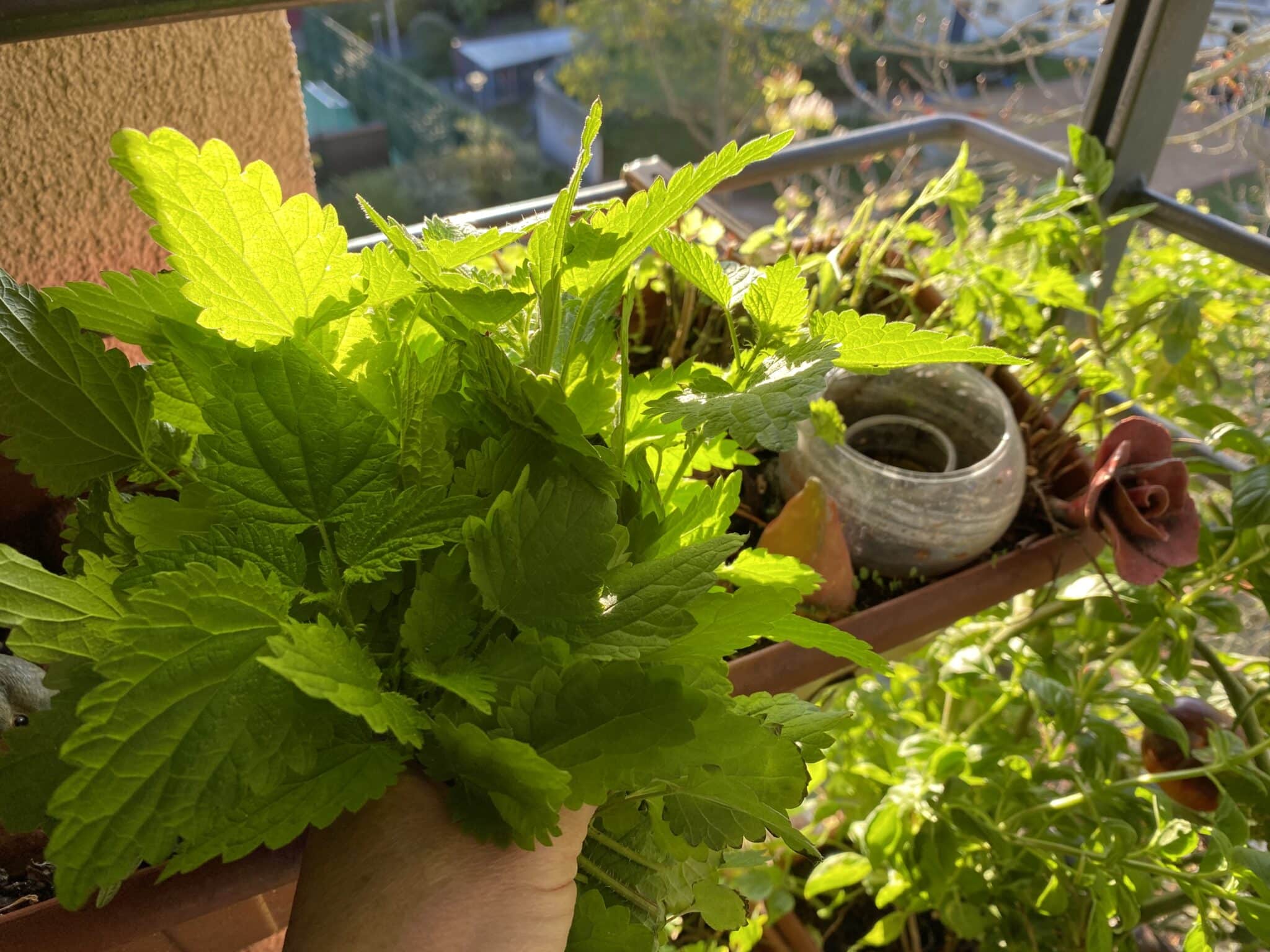

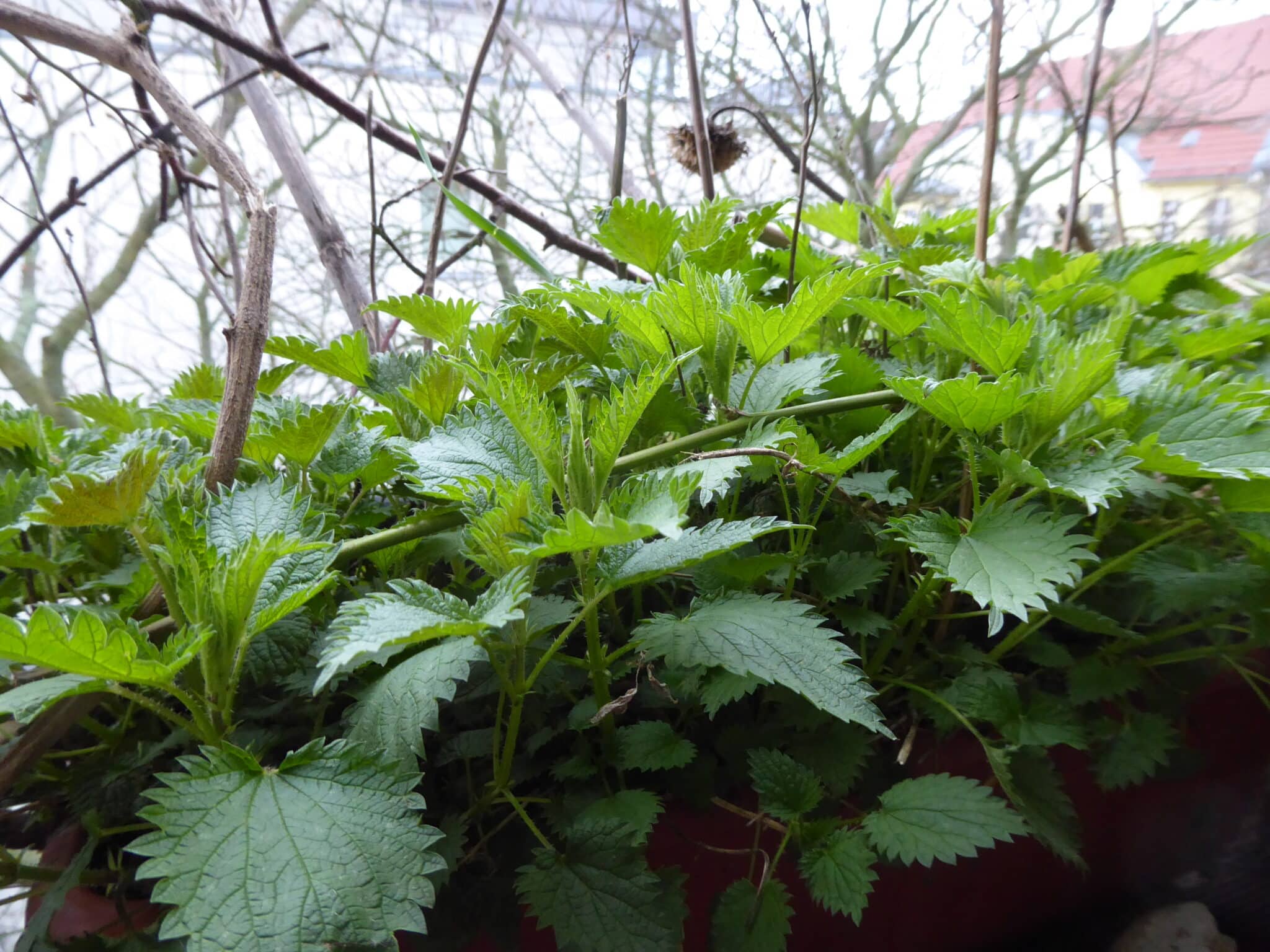
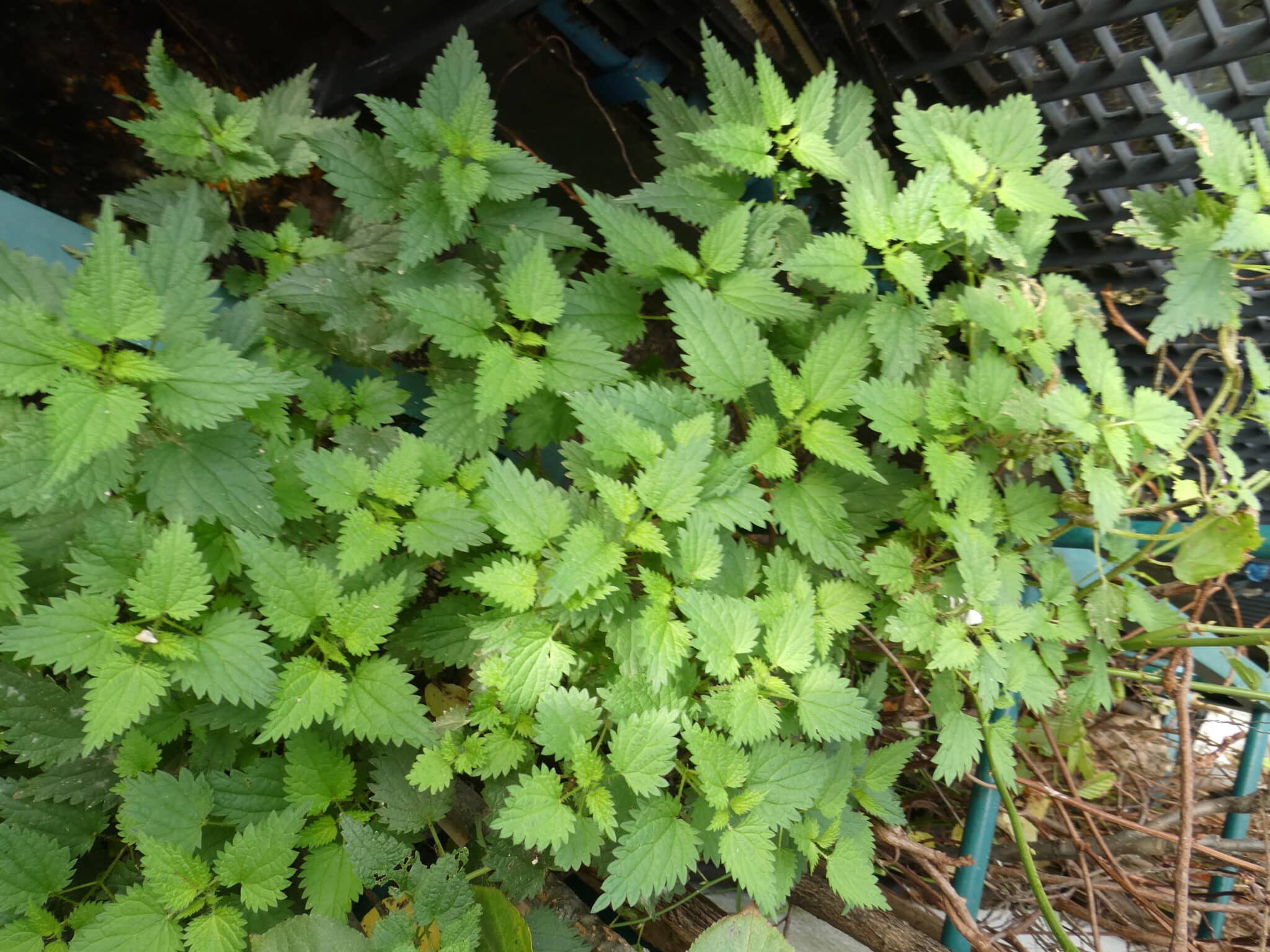



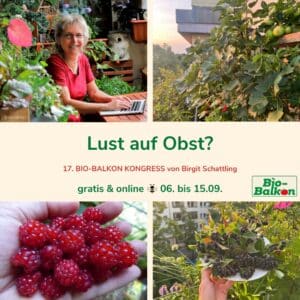


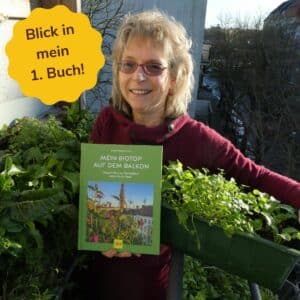

21 Responses
I think it’s a great idea, so I’m in. Once you understand the health benefits of nettles and the like, you’ll find the space on your balcony. I wish you lots of luck and perseverance.
Thank you for your kind words.
1000 thanks for your wonderful blog. So much inspiration. Ana
Hello, we do that too!
Apart from nettles, we also have wild vegetables growing on our supermarket balcony:
Goutweed, ribwort plantain, chickweed, wheatgrass, amaranth, dandelion, sorrel & C0.
In other words, the whole range of dreaded garden weeds. But for those who know, it is a misunderstood superfood!
Why cover the balcony with some non-edible exotic flowers that will only be thrown away anyway?
Our balcony wild vegetables and wild plants end up fresh in smoothies in salads and as healthy delicacies in cooked dishes. Just like our diverse herbs and cultivated balcony vegetables.
The rest of the oversupply is dried for winter use.
Our call to you: Just give it a try.
Dear friends of the wild plant and wild vegetable balcony! Hopefully many of you will read your appeal, I really hope so. Unfortunately, the good ingredients of so-called weeds are largely unknown. Let’s promote them, let’s promote our regional superfood, which we can even grow on our own balconies. I loved reading your appeal, it really speaks to my heart! Do you live in the city? Have you been doing it for a long time? I am interested in sharing my experiences. In addition to the many nettles, I also grow goutweed, ribwort plantain, chickweed, wheatgrass, amaranth, dandelion, sorrel, burnet, wild rocket, willowherb… Many things are brought by the birds or the wind, some are sown or dug up. Everything goes into my beloved healthy green smoothies, which give me energy and health.
I am very happy to read that there are more such crazy people!
I’ve just realized that, as a crazy person, I haven’t even replied yet. They are excellent balcony plants that I am very happy to recommend. It’s great that you are one of them. Keep up the good work. Best regards Birgit
Hi, would it be possible for you to share your recipe for the green smoothie here?
Dear Amy. Here is my standard recipe, which I always use. The important thing is rotation, variety and a slow approach to wild herbs:
A handful of green leaves in a variety: carrot greens, radish greens, kohlrabi greens, cabbage, beet leaves, parsley, lamb’s lettuce, spinach, Swiss chard.
Add a variety of wild herbs: nettles, goutweed, dandelion, burnet, mugwort, rocket… As I’ve been doing this for a long time, I can use more of them. As a beginner, start with just a few wild herbs of one type.
A handful of sprouts https://bio-balkon.de/sprossen-und-microgreens-ganzjaehrig-gaertnern-auf-der-fensterbank/ https://bio-balkon.de/empfehlungen/gaertnern-auf-kleinstem-raum-sprossen-keimlinge-graeser/Radishes, broccoli, alfalfa, peas, cress, sunflower.
My homemade kombucha https://bio-balkon.de/fermentierst-du-schon-kombucha-selber-machen/ instead of water.
Fresh ginger and turmeric (about half a thumb), as anti-inflammatory and antioxidant.
Some cayenne pepper and green pepper, as it supports the production of digestive juices and the absorption of nutrients.
1 tbsp raw Coconut oil from Dr. Goerg
To make it taste good, fruit with a low glycemic index should be added. As an advanced smoothie drinker, I leave out the fruit. I like to add a piece of cucumber.
Kind regards Birgit
Does nettle grown in a flower pot in normal potting soil have the same good ingredients as when it is picked in the wild?
I ask myself this because stinging nettle only grows naturally in certain places where the soil provides it with the right conditions.
Thank you for your answer.
I’m going to assume that. If the nettles didn’t like the conditions in the planter, they wouldn’t grow so abundantly and everywhere. They are in a lot of planters and have become very well established. My soil is spiced up with worm humus from my worm box. I also fertilize with Effective Microorganisms. It’s no longer “normal” potting soil from the bag. But I am convinced that they would also grow in normal potting soil. There are no studies on the content. Nobody is interested in that, nobody spends money on such tests.
Hello and thanks for the nice report. I also have nettles in my balcony box for the first time this year. I have a question about this. Do you have the plants alone in a box or together with others? Do they possibly get along with other wildflowers in the same box?
Dear Claudia, I find them too assertive and prefer to leave them alone in the balcony box. In the wild, a nettle plant can overgrow 1.5 m². The permaculturist Ulrike Windsperger recommends it as an underplanting for columnar apples. I still have them around a jostaberry. Kind regards Birgit
I’ve been growing dandelions and chickweed on my balcony for 2 years now after I had to give up my garden. That way I can harvest fresh for breakfast and know that no dog has been on it 🙂
I have a huge flower pot with a large mixture of wild herbs on my friend’s balcony!
I’m still missing stinging nettle! It really is a great superfood, but I can only use it sparingly because of the histamines.
It’s great that others have wild herbs on their balconies too!
Dear Conny, I also think it’s great that you grow edible wild herbs for consumption. It’s so easy, they are so robust and healthy. The stinging nettle is also very valuable because it is so vigorous and can be pruned several times. Kind regards Birgit
A tiny flower meadow in the balcony box also works. It attracts lots of insects, including bumblebees, which I need to pollinate my balcony tomatoes. The meadow is also a really beautiful sight, so it’s superfood for the eyes!
Hello Birgit, thank you very much for your beautiful page about the “divine” nettle.
It has relieved me of years of knee pain. No medication or other recommendations helped. An intensive touch of the plant on both knees three times a week for a month was enough.
I love this plant. It also tastes excellent. Kind regards Anja
Dear Anja, thank you for your confirming report on what a great plant stinging nettle is. I remember experiencing this intense touch for knee pain. My companions had a lot of fun with this “whipping” back then. It is now firmly established in my mind that you can endure nettle pain, it promotes blood circulation. When I harvest nettles, I don’t use gloves, it promotes blood circulation. All the best from Birgit
I also belong to the local wild herb superfood fan group.
I’ve read that stinging nettles also draw iron from the soil, which is why they also grow in scrap yards. Does it also contain iron in the balcony box if there is little or no iron in the soil? Or should I add a rusty decorative flower plug? I really mean this seriously, even if it sounds strange.
Dear Claudia, I can’t give you any reliable information on this. I am sorry. Kind regards Birgit
Hello Claudia,
to your question as to whether you need to add rusty iron to the soil with the nettles?
No, of course not. Many plants contain iron, among other things.
However, if you really want to get plenty of iron, you should definitely eat dandelion leaves.
It contains about 30 times more iron than stinging nettles. This is why I hardly ever remove dandelions from my flower beds, because they protect woody plants from chlorosis (= iron deficiency) due to their high iron content.
Ulrike Windsperger, permaculturist